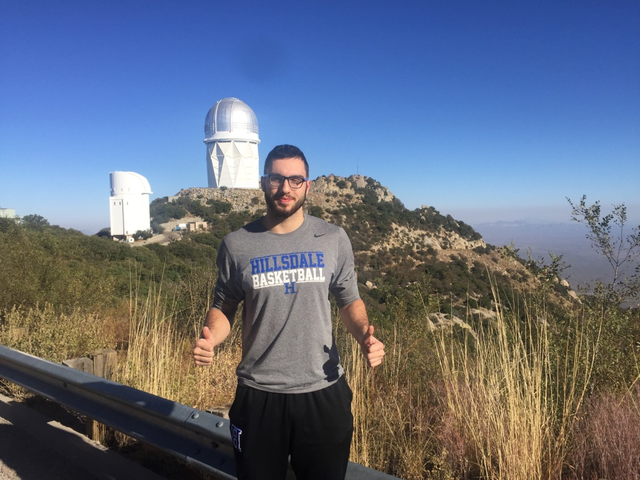
Students at Hillsdale College no longer have access to using the telescope at Kitt Peak National Observatory, after the National Science Foundation’s astronomy division divested from the project this year.
The physics department has taken two trips to the Tucson, Arizona, observatory this year, after the foundation approved proposals that Assistant Professor of Physics Tim Dolch submitted for research on bow-shock nebulae. The visits mark some of the final opportunities for public access to the observatory after a consortium of several universities bought it and are not accepting research proposals from outside astronomers.
The divestment and privatization of small-to-mid-sized telescopes has become a trend, as the foundation looks to devote its resources to larger telescopes that may not have the same accessibility to science, technology, engineering, and mathematics, or STEM, students. That shrinks the research opportunities for many, especially those at smaller colleges and universities such as Hillsdale, Dolch said.
“Student accessibility has got to be a factor in divestment decisions,” Dolch said. “Why do people go in the direction of STEM careers? It’s because you have an interesting experience, so I don’t think you can underestimate that value of being an undergraduate, using a world-class facility, and having that direct experience of exploring something in nature.”
At Kitt Peak, researchers could submit observing proposals to request use of the Mayall 4-Meter Telescope. An anonymous committee would review them and either reject the request or allot time for their use of the telescope.
“People are really disappointed, because this telescope has been the place to go to for a long time for optical astronomy,” said sophomore Christopher Scheithauer, who traveled to Kitt Peak over the summer with Hillsdale.
Dolch received approval to search for bow-shock nebulae this summer and at the end of October. The nebulae form when pulsars, rotating neutron stars that emit radio waves, plow through interstellar gas. Dolch has interest in them because they can be used to help identify gravitational waves coming from merging supermassive black holes, which have yet to be detected, and explain why the waves arrive to Earth when they do.
“It’s part of the story of galaxy evolution,” Dolch said. “These black holes exist in the center of galaxies. They merge with each other, and a lot of our own galaxy’s history probably has to do with mergers in the distant past. And in the future, we are going to merge with the Andromeda Galaxy.”
During the first visit this summer, monsoon season prevented Dolch, junior Laura Salo, and Scheithauer from opening the dome and collecting data.
Over fall break, however, senior Christos Giannakopoulos and Dolch stayed up two nights in a row and successfully photographed the heavens with the Mayall 4-Meter Telescope for Giannakopoulos’ senior thesis. He will review the images collected from 40 pulsars to find a bow-shock nebula, if possible, and identify an upper limit for the exposure time used to generate the images.
“I was so lucky to be one of the last non-consortium student to use it,” Giannakopoulos said. “I’m very grateful for that. I’ve been interested in astrophysics since I was young, and it stimulated my interest even more.”
Dolch said it is disappointing to no longer have the opportunity to use Kitt Peak’s telescope, since its 4-meter diameter is an ideal size for observing the nebulae.
While there are a few other similarly sized telescopes available, to which he has already submitted observing proposals, Dolch expressed concerns that the focus on building 10-meter or 30-meter telescopes limits resources available to STEM students.
“Building bigger and better telescopes doesn’t mean the discovery potential of existing telescopes is anywhere near over,” Dolch said. “There’s a certain philosophy there that I am not sure is sustainable long-term.”
Arecibo Observatory in Puerto Rico also is facing a threat of divestment. Hillsdale students access its radio telescope about once a month through the North American Nanohertz Observatory for Gravitational Waves and control it from the Radio Telescope Remote Command Center in the Strosacker Science Building to collect data on gravitational waves. A much larger facility than Kitt Peak, Arecibo has had more challenges finding a private owner.
“We’re hoping some last-minute funding might come through,” Scheithauer said. “At a college as small as Hillsdale, you wouldn’t think you would have access to these world-class instruments. I never thought I would be able to control one of the largest moveable objects on the planet.”
Dolch said he does have hope that more resources will be devoted to exploring gravitational waves in the future. Every 10 years, the National Academy of Sciences conducts its Astronomy and Astrophysics Decadal Survey, which reviews where it allocates its resources and prioritizes where it will invest them for the next decade.
Given the lack of progress on detecting gravitational waves in 2010, the foundation began moving away from supporting the endeavor.
Since then, however, the Laser Interferometer Gravitational-Wave Observatory has detected gravitational waves, reviving interest in the research and renewing the hope of discovering new astrophysical phenomena in space.
“Gravitational waves are a whole new way of seeing the sky,” Dolch said. “There are all kinds of physics that are opening up.”

